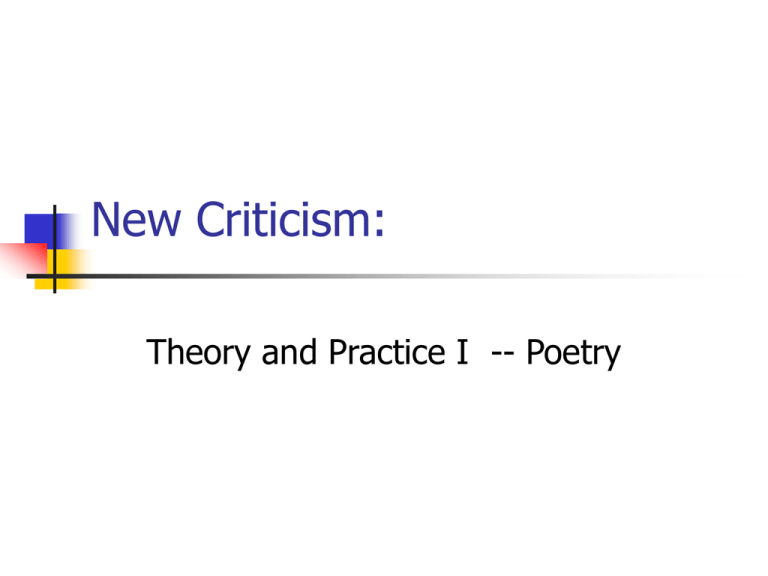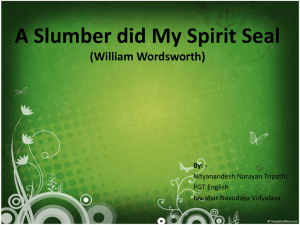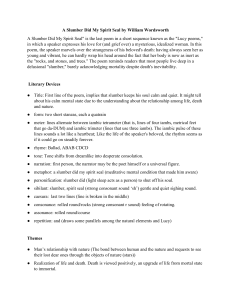New Criticism
advertisement

New Criticism: Theory and Practice I -- Poetry Outline New Criticism: Assumptions New Criticism: Methodologies Example 1: “A Slumber did My Spirit Seal” Example 2: “This is Just to Say”: an Intrinsic (New Critical) Analysis and an Extrinsic one. New Criticism: in Historical Context Starting Questions Autonomy: Do you think that great writers such as Shakespeare and Milton can transcend their time and space? How about a text? Can a text present universal experiences and speak to people of different ages in the same way? How about you? To what extent can you determine your life and its meanings? Textual Unity: Is it always possible to find in a text unity of form and content, or of its different parts? How do you deal with its contradictions? Objective reading: Is objective reading of a poem possible? Is it possible to not involve your personal experience? New Criticism: Major Assumptions (text pp. 41-42 ) A poem is an autonomy (獨立個體), its meanings decided by itself alone, but not by the author’s intention or the reader’s emotional responses to it. Intentional Fallacy (意圖謬誤), Affective Fallacy (感情謬誤) Poetry offers a different kind of truth (poetic truth) than science, conveyed through its dense language which cannot be translated. Heresy of Paraphrase Major Assumptions —Textual Autonomy the poet‘s mind as a catalyst (觸媒) Experience, objective correlatives CO2+葉綠素 光合作用 objective correlative 客觀對應物 (T.S. Eliot) An external object used to convey the writer’s feeling, which is elevated to a universal level in writing and the use of objective correlatives. “The only way of expressing emotion in the form of art is by finding an ‘objective correlative’; in other words, a set of objects, a situation, a chain of events which shall be the formula of that particular emotion; such that when the external facts, which must terminate in sensory experience, are given, the emotion is immediately evoked.” (“Hamlet and His Problems”) objective correlative: e.g. 客觀對應物 (T.S. Eliot) e.g. Images of coldness in Hardy’s “Neutral Tones” e.g. “. . . the sun was white, as though chidden of God ” “The Love Song of J. Alfred Prufrock” “Let us go then, you and I, When the evening is spread out against the sky Like a patient etherized(乙醚麻醉) upon a table” ( Are they objective or subjective?) New Criticism: Major Assumption (2) – poetic truth 1. The text’s meaning resides within its own structure. 2. organic unity: all of its elements (form and content, poetic elements, tensions) form a “single unified effect.” (text 43) all parts of a poem are interrelated and interconnected, with each part reflecting and helping to support the poem's central idea. ...allows for the harmonization of conflicting ideas, feelings, and attitudes, ... New Criticism: Methodology New Criticism’s synonyms = objective criticism, practical criticism, textual criticism, close reading (text 38) the "text and the text alone" approach New Criticism on Poetry (text 44 - 45) 1. Pay close attention to the text’s diction its meanings (connotation and denotation) and even its etymological roots. 2. Study the poetic elements closely. e.g.詩律(prosody)、比喻語言(明喻、暗喻、 擬人法、頓呼法) 3. Search for structure and patterns; e.g. oppositions in the text (paradox, ambiguity, irony) 4. From Parts to an Organic Wholeness New Criticism: Methodology (1) Poetry Whole Parts Denotations, connotations and etymological roots Allusions Themes Prosody pattern, tension, Relationships ambiguities, among paradox, the various elements contradictions New Criticism: Methodology (1) Narrative Whole Parts Point of view, dialogue, setting, Themes Plot Characterization pattern, tension, Relationships ambiguities, among paradox, the various elements contradictions “A Slumber Did my Spirit Seal” 1. Circle the important words 2. Find patterns A slumber did my spirit seal; Light sleep, I had no human fears: death She seemed a thing that could not feel The touch of earthly years. Negative; no action no feelings No motion has she now, no force; She neither hears nor sees; Rolled round in earth's diurnal course, With rocks, and stones, and trees. William Wordsworth 1799 “A Slumber Did my Spirit Seal” pattern 2: rhymes and contradictions A slumber did my spirit seal; I had no human fears: She seemed a thing that could not feel The touch of earthly years. No motion has she now, no force; She neither hears nor sees; Rolled round in earth's diurnal course, With rocks, and stones, and trees. Negatives resolved by the cosmic positives. “A Slumber Did my Spirit Seal” Possible Argument Her death is accepted by the speaker as time goes by, first by having no fear of mortality, and then by developing a broader view of her being one in universe. Supported by the long vowels, and long sentences. Is it a complete acceptance? “A Slumber Did my Spirit Seal” pattern 2: rhymes and contradictions A slumber did my spirit seal; I had no human fears: She seemed a thing that could not feel The touch of earthly years. A gap No motion has she now, no force; She neither hears nor sees; Rolled round in earth's diurnal course, With rocks, and stones, and trees. “A Slumber Did my Spirit Seal” Revised Argument With regret over her loss of human actions, the speaker manages to accept her death, first by having no fear of mortality, and then by developing a broader view of her being one in universe. Traditional/Extrinsic Questions: “A Slumber Did my Spirit Seal” Author/Biographical study: Who wrote it? How do we know? Who is ‘she’? When did she live and die? Why did she die? How are the two related to each other in life? Manuscript study: When was it first published? When first written? Is there a manuscript version? Are there any textual variants between manuscripts and printed versions? . . . History of Ideas: Are the poem’s philosophical or moral ideas characteristic of the author, or the period in which it was written? Does the poem reveal any literary or philosophical influences? A Handbook to Literary Research. Eds. Simon Eliot and W.R. Owens. NY: Routledge in Association with Open U, 1998: 86. This Is Just To Say (Intrinsic) I have eaten the plums that were in the icebox and which Forgive me they were delicious so sweet and so cold. you were probably saving for breakfast Lack of punctuation; The title irregular syntax This Is Just To Say (Extrinsic) William Carlos Williams’ experimenting with type-writer the influence of Imagism and Haiku Comparison with the other poems or texts on food? Free Associations? This Is Just To Say : Main Idea for Paper Writing? 1. Despite the apparently casual title and syntax matching the banality of its topic, the poem reveals and celebrates the sensual beauty of daily objects. “This Is Just To Say” : Other possible readings 1. 2. 3. The poem could be concerned with the uselessness or self-entrapment of sexual desire, comparable to "Th'expense of spirit in a waste of shame.“ There's the potential Oedipal reading, with the boy thwarted in an attempt to comprehend his origin; to learn of it from his mother. Or there's the reading that would suggest selfreferentiality; it is the poem itself that "means nothing." From World, Self, Poem: Essays on Contemporary Poetry from the "Jubilation of Poets." Ed. Leonard M. Trawick. Copyright © 1990 by The Kent State University Press. http://www.english.uiuc.edu/maps/poets/s_z/williams/just.htm New Criticism in Context Extrinsic studies: e.g. biographic studies, textual scholarship (historical studies), Impressionist approach, New Criticism: set up literary studies as a professional discipline // Russian Formalism New Criticism: Historical context After the second world war Like existentialism, New Criticism tries to retain human values. New Critics 1. re-direct critical attention from the external to the internal (textual), 2. Upholds liberal humanism in face of worldly chaos. (The most valuable is our free will.) Williams’ explanation of why "This Is Just To Say" is a poem. . . . in an interview of 1950, John W. Gerber asked the poet what it is that makes "This Is Just To Say" a poem, Williams replied, "In the first place, it metrically absolutely regular. . . .So, dogmatically speaking, it has to be a poem because it goes that way, don't you see!" But the. . .stanzas exhibit no regularity of stress or of syllable count; indeed, except for lines 2 and 5 (each an iamb) and lines 8 and 9 (each an amphibrach), no two lines have the same metrical form. What then can Williams mean when he says, "It's metrically absolutely regular"? Again, he mistakes sight for sound: on the page, the three little quatrains look alike; they have roughly the same physical shape. It is typography rather than any kind of phonemic recurrence that provides directions for the speaking voice (or for the eye that reads the lines silently) and that teases out the poem's meanings. Marjorie Perloff From The dance of the intellect: Studies in the poetry of the pound tradition. Copyright © 1985 by Cambridge University Press. http://www.english.uiuc.edu/maps/poets/s_z/williams/just.htm





